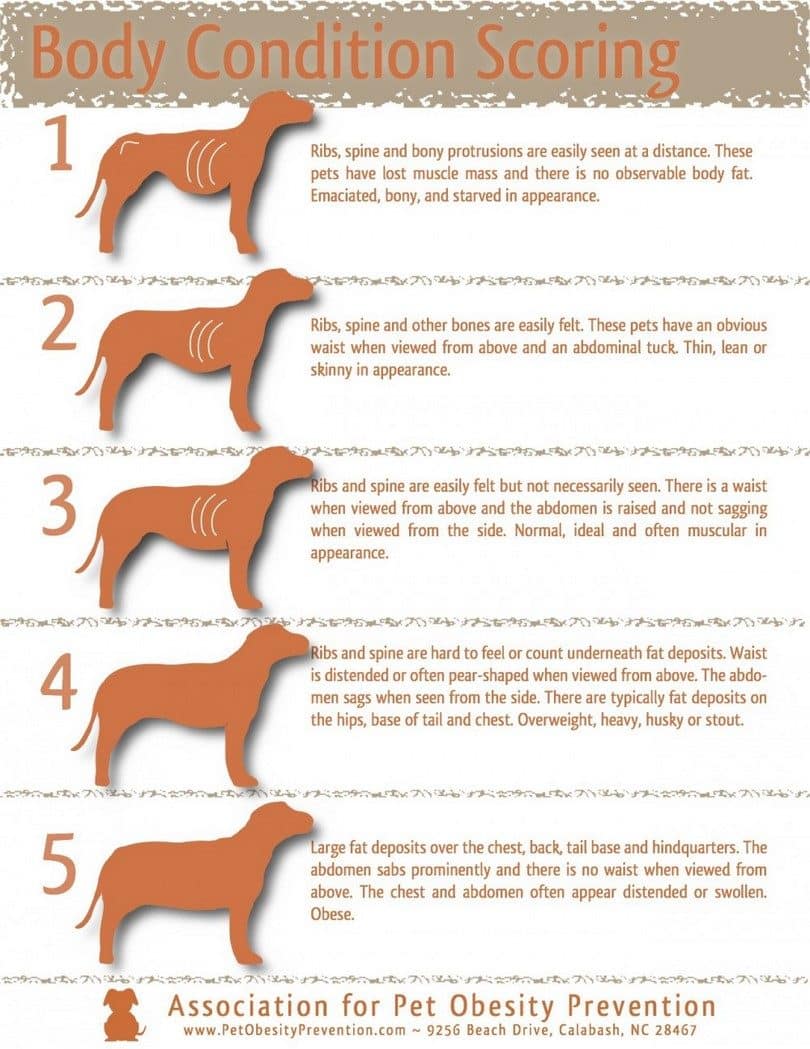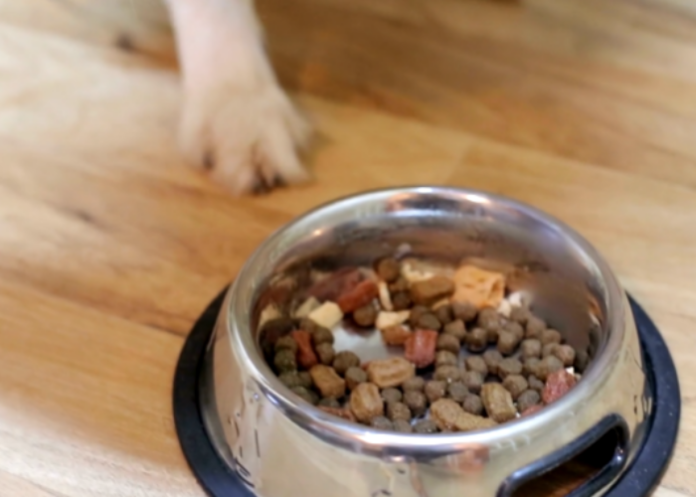Pet parents often find themselves wondering if Rover is getting too much (or too little) to eat. After all, the feeding instructions on your dog’s food label are just a ballpark figure; a dog’s breed, size, and activity level all must be taken into consideration when determining how much to feed your furry friend.
Portion sizes can vary drastically for a pup that is a couch potato compared to a hunting dog, and if you have a Pomeranian instead of a Saint Bernard, then that must certainly be taken into account.
So if you find yourself asking the common question, “how much should I feed my dog,” read on to discover the importance of determining an accurate portion size instead of simply guessing.
First Step: Visit Your Vet
Whether you are adopting an 8-week-old puppy or a senior dog, a trip to the veterinarian should be the first stop on your list. Your vet will weigh your dog and be able to tell you if he is underweight, overweight, or if he is at an ideal weight.
Most veterinarians will not only consider the dog’s breed when making this determination but also complete a physical exam. Dogs are at an ideal weight when they have a distinct waistline that is narrower than the rib cage.
Your vet will also feel your dog’s ribs—underweight dogs typically have highly visible rib cages that poke out, while overweight and obese dogs’ ribs can’t be felt at all. Your dog should fall somewhere in the middle.
Most importantly, your veterinarian will rule out any medical problems that may be contributing to your dog’s weight problem. Chronic illnesses like hypothyroidism can lead to obesity, while parasites can cause a dog to lose weight.

Your vet can help you come up with a plan of action, including recommending how much your dog should eat. Regular checkups will also help Fido to stay on track, although many pet parents weigh their dogs at home in between visits to monitor their dog’s weight.
If you have trouble getting your pup to balance on the scale, try this trick: weigh yourself, then stop off the scale, pick up your pup, and step back on the scale. Then simply subtract the two numbers to find your dog’s weight. If your dog is too heavy to comfortably pick up, most vets will happily weigh your dogs free of charge.
How Much to Feed Your Dog
There is a scientific method dog nutritionists use to specify a dog’s caloric needs based on the dog’s weight, activity level, and stage of life. The formula was invented because the caloric needs of a pregnant Chihuahua, an unneutered male sled dog, and a spayed Labrador Retriever with a normal activity level will look drastically different from one another. To use the method, you first need to figure out your dog’s weight in kilograms, so divide his weight (in pounds) by 2.2 to get the number.
However, it is important to note that you want to use his ideal weight if his current weight is unacceptable, otherwise, you will simply be maintaining his current weight.

Next, you want to determine his resting energy requirement (RER for short):
- RER= (weight in kg x 30) + 70
Now, plug in your dog’s RER into the table below based on your dog’s activity level and stage of life:
The resulting number, or your dog’s Daily Energy Requirement, is given in kilocalories, which is the typical measurement on most dog food labels.
In short, if your dog is consuming more kilocalories per day than his Daily Energy Requirement, he is probably overeating. If he is consuming less than you probably need to increase his daily food intake. If the above numbers seem overwhelming to you, there is a different option:
Trial and Error

Next, make an educated guess based on the food label instructions on serving size (but if in doubt, try feeding a little less than the recommended amount if your dog falls in between two ranges).
Remember to always use a measuring cup and not a food scooper or other unmarked container.
If you like the idea of trial and error but also want some solid statistics on your side, check out “dog food calculators” online that will allow you to input your dog’s weight, activity level, and age, and you will be given a recommended daily caloric intake that your dog requires.
Over the next couple of weeks, monitor your dog’s weight and see if adjustments need to be made. If your dog is overweight and needs to shed some pounds, make sure he is not losing more than 2% of his body weight per week. Conversely, if your dog is gaining weight, he should gain weight at a healthy track.
The Overweight Dog
Nearly one out of three dogs in the U.S. is overweight, and it is probably not surprising that overweight dogs belong to overweight owners. Dogs that are obese live significantly shorter lives than their healthy counterparts, and of course (just like people), dogs are happier when they are slim and active instead of heavy and lazy.

In addition to making sure your dog’s feeding amounts are correct, the other way to ensure your dog’s weight stays in check is to control the number of treats you give and limit table scraps. It is also essential to exercise your dog daily.
The good news is that exercise for your pup doesn’t necessarily mean exercise for the owner; if your dog loves swimming, take him to a dog-friendly lake, and if he gets along well with other dogs, take a visit to your local dog park where he can run to his heart’s content.
If you’d like to learn more about ho to help your pudgy pooch, take a look at this article on signs and solutions for overweight dogs.
The Underweight Dog
While certainly, not an epidemic like obesity is for our canines, be sure that a licensed veterinarian examines your underweight dog. Dogs may refuse food when they are ill, have dental problems, or are suffering from chronic diseases like parasites.
Dogs that are rescued from neglectful circumstances, or puppies taken from puppy mills are often underweight, so be sure (with the approval of your vet) that you offer high-quality food to him at all times (also known as free feeding) until the desired weight is reached.
If you’re experiencing issues with your dog losing weight, consider this article discussing why your dog won’t eat.
Free Feeding VS Set Meal Times
Whenever you bring your dog home, you need to decide on a feeding schedule. While some dog owners choose to leave a large bowl of food out all day for their dog to simply eat whenever they choose, most veterinarians and professional dog trainers agree that having a set time for morning and evening meals is a healthier option—both from a behavioral standpoint and also a physical one.
Behaviorally, dogs are prone to recognize their owner as the leader of the pack when you are the own who provides (and subsequently removes) their food bowl on a daily basis. Physically, dogs that have set meal times are easier to potty train because they typically need to eliminate shortly after eating.
Conversely, dogs that have the option to free feed tend to overeat. Some dogs want to satisfy their natural urge to “forage” during the day and will continually eat out of their food bowl even though they are not truly hungry. A great alternative for your dog can be to leave a puzzle-style toy with him during the day that will keep his mind (and paws) occupied.
While some owners find their dogs are satisfied only eating one meal a day, most pet parents find their dogs are happier and healthier with two set meals: morning and evening. Keep in mind that if you do follow the portion size listed on your dog’s food label, the amount listed is for the day (not per feeding), so be sure to divide the number in half.
Other Considerations

There are many factors to take into consideration when it comes to figuring out how much to feed your dog:
The Bottom Line
As pet parents, it is our responsibility to ensure that our dogs maintain a healthy weight, and the biggest factor of obesity in dogs is overfeeding. We owe it to our dogs to give them long and healthy lives, and other than the love and attention we give them, the quality and quantity of food we give them ranks high on list in terms of quality of life for your dog.
So while it may easier to guess how much you should be feeding Fido, and certainly cheaper to buy him the bargain brand at a large chain store, we owe it to our companions to make the right decisions for them.
Many pet owners give their dogs too much food or too many treats because they are under the impression that giving food is the best way to show their dog love. On the contrary, scientific studies have proven that the majority of dogs prefer praise and physical affection from their owner over food any day of the week.




